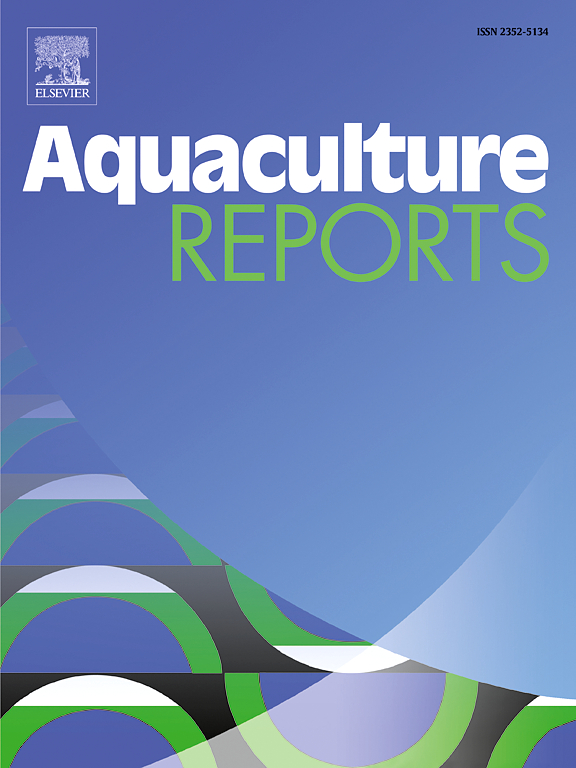三龙骨塘龟和红耳滑龟幼龟生长对饲料摄取量的不同响应
IF 3.7
2区 农林科学
Q1 FISHERIES
引用次数: 0
摘要
海龟养殖业是一个迅速发展的产业,但对海龟的饲料依赖生长性能的了解有限。本研究对中国三龙骨塘龟和红耳滑龟幼龟的生长性能、生理变化和肠道微生物群的变化进行了研究。饲喂14 d时,饲粮超过体重的1 %,使两只龟生长迅速。当饲料比例为体质量的2.5 %时,线虫的生长速率进一步提高,而线虫的生长速率则没有提高。饲料比例的增加分别促进了线虫肝脏和肌肉的葡萄糖代谢。两种龟的脂肪酸代谢均被激活,蛋白质代谢增强。在线虫的肝脏和线虫的肌肉中观察到积累的甘油三酯或蛋白质。琥珀酸脱氢酶和胰岛素样生长因子2的调控可能与这些过程有关。饲料比例的提高改变了reevesii氧化还原稳态,降低了免疫功能。高饲料比例增加了reevesii的肠道病原体,而增加了秀丽隐杆线虫肠道益生菌乳酸杆菌。这些种间差异可能是高食物供应条件下两种龟生长性能不同的原因。本研究结果可为龟类养殖的饲料管理和优化饲养效率提供参考,并可指导提高淡水龟生长性能的潜在策略。本文章由计算机程序翻译,如有差异,请以英文原文为准。
Different growth responses to feed ration levels in two freshwater turtle juveniles, the Chinese three-keeled pond turtle Mauremys reevesii and the red-eared slider Trachemys scripta elegans
Turtle aquaculture is a rapidly expanding industry whereas the knowledge about the feed ration-dependent growth performances of turtles is limited. The present study investigated growth performance, physiological changes, and alterations in gut microbiota at gradient daily feed rations in two turtle juveniles, the Chinese three-keeled pond turtle Mauremys reevesii and the red-eared slider Trachemys scripta elegans. During 14 days of feeding, the feed rations exceeding 1 % body mass induced the rapid growth of both two turtles. The growth rates further increased at the feed ration of 2.5 % body mass in T. scripta elegans, but not in M. reevesii. Increased feed rations enhanced glucose metabolism in the liver of T. scripta elegans and the muscle of M. reevesii, respectively. Fatty acid metabolism was activated in both two turtles and protein metabolism was enhanced in M. reevesii. Accumulated triglyceride or protein was observed in the liver of T. scripta elegans and the muscle of M. reevesii. The regulation of succinate dehydrogenase and insulin-like growth factor 2 may relate to these processes. Raised feed rations changed redox homeostasis and decreased immune function in M. reevesii. High feed rations increased gut pathogens in M. reevesii whereas increased the probiotic Lactobacillus in the gut of T. scripta elegans. These interspecific differences may contribute to the different growth performances between these two turtle species under high food availability. Our results provide information for feed management and optimizing feeding efficiency in turtle aquaculture, and can guide the potential strategies to improve the growth performance of freshwater turtles.
求助全文
通过发布文献求助,成功后即可免费获取论文全文。
去求助
来源期刊

Aquaculture Reports
Agricultural and Biological Sciences-Animal Science and Zoology
CiteScore
5.90
自引率
8.10%
发文量
469
审稿时长
77 days
期刊介绍:
Aquaculture Reports will publish original research papers and reviews documenting outstanding science with a regional context and focus, answering the need for high quality information on novel species, systems and regions in emerging areas of aquaculture research and development, such as integrated multi-trophic aquaculture, urban aquaculture, ornamental, unfed aquaculture, offshore aquaculture and others. Papers having industry research as priority and encompassing product development research or current industry practice are encouraged.
 求助内容:
求助内容: 应助结果提醒方式:
应助结果提醒方式:


